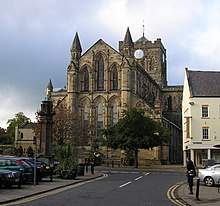Hexham Abbey
| Hexham Abbey | |
|---|---|

middle of Hexham Abbey
|
|
| Country | United Kingdom |
| Denomination | Church of England |
| Previous denomination | Roman Catholic |
| Churchmanship | Broad Church |
| Website | hexhamabbey.org.uk |
| Administration | |
| Parish | Hexham |
| Diocese | Newcastle |
| Province | York |
| Clergy | |
| Rector | Dagmar Winter |
| Priest(s) |
Matthew Hunter Alan Currie |
| Laity | |
| Director of music | Marcus Wibberley |
| Organist(s) | Michael Haynes |
Matthew Hunter
Hexham Abbey is a leading historical attraction and place of Christian worship dedicated to St Andrew located in the town of Hexham, Northumberland, in northeast England. Originally built in AD 674, the Abbey was built up during the 12th Century into its current form, with additions around the turn of the 20th Century. Since the Dissolution of the Monasteries in 1537, the Abbey has been the parish church of Hexham. In 2014 the Abbey regained ownership of its former monastic buildings, and subsequently developed them into a permanent Exhibition and Visitor center, telling the story of the Abbey's history. Onsite there is also a Refectory Cafe and gift shop, catering to over 100,000 visitors each year.
There has been a church on the site for over 1300 years since Etheldreda, Queen of Northumbria made a grant of lands to Wilfrid, Bishop of York c.674. Of Wilfrid's Benedictine abbey, which was constructed almost entirely of material salvaged from nearby Roman ruins, the Saxon crypt still remains; as does a frith stool, a 7th/8th century cathedra or throne. For a little while around that time it was the seat of a bishopric.
In the year 875 Halfdene (Halfdan Ragnarsson) the Dane ravaged the whole of Tyneside and Hexham Church was plundered and burnt to the ground.
About 1050 one Eilaf was put in charge of Hexham, although as treasurer of Durham, he probably never came there. Eilaf was instructed to rebuild Hexham Church which then lay in utter ruin. His son Eilaf II completed the work, probably building in the Norman style.
In Norman times Wilfrid's abbey was replaced by an Augustinian priory. The current church largely dates from c.1170–1250, built in the Early English style of architecture. The choir, north and south transepts and the cloisters, where canons studied and meditated, date from this period.
...
Wikipedia
